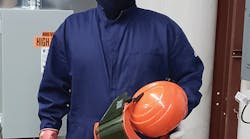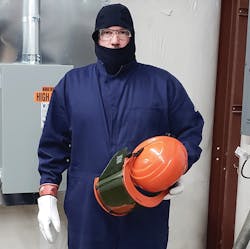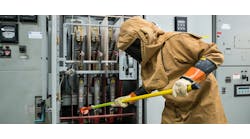Most electrical workers today recognize that, in recent years, a major emphasis has been placed on arc flash hazard recognition. Depending on the maturity of your company’s electrical safety program, your personal experience may vary greatly from your peers in the industry. However, a scenario exists that is still far too common for electrical workers.
The scenario might go something like this: Your company finally recognized that you need to be protected from this arc flash hazard “thing.” The company hired some engineering firm to come collect drawings and information on the system, and then they ran out and put arc flash hazard stickers on all the equipment. The next thing you know, your supervisor dumps a pile of arc flash personal protective equipment (PPE) in your lap, and tells you it is a requirement for you to wear it. What do you do now? The following article will try to help you answer that question.
Are all arc flash PPE items applicable for all scenarios?
The answer to this question is, “absolutely not!” When an arc flash analysis has been performed and stickers have been placed on your equipment, these stickers will include incident energy levels or arc flash PPE categories on them. The incident energy level should be listed in cal/cm2. This means that the highest energy level that this equipment will produce in an arc flash event will not exceed the posted cal/cm2 rating. Your arc flash PPE should contain a tag that has an arc thermal protective value (ATPV) rating (also listed in cal/cm2). The ATPV rating means that the rated PPE will protect the wearer from arc flash energies up to that ATPV value. The arc flash PPE is only effective for equipment that has incident energy levels that are lower than the ATPV rating of the PPE. This is a fundamental understanding that all electrical workers should have.
How can you be sure you are wearing the correct PPE for the task at hand?
Following these two steps can help you determine if you are wearing the correct PPE for the task you’re performing:
Step 1: Identify the hazard that you need to protect yourself from.
For the sake of this discussion, we are going to limit the hazards to electrical-specific hazards: electric shock and arc flash. With respect to shock hazards, note that arc flash PPE does not typically provide shock protection. If a potential shock hazard exists, then shock PPE must be considered in addition to the PPE discussed in this article (as well as fall protection, confined spaces, etc.).
Let’s assume you know there’s an arc flash hazard associated with the task you are about to perform. How do you determine the severity of the arc flash hazard? The severity is defined by the incident energy level. If there is a sticker on the equipment from an arc flash analysis, then the sticker will tell you the incident energy or the minimum level of PPE required. If there is no sticker, then you must reference NFPA 70E Table 130.7(C)(15)(A), Tables a & b. Based on this information, you should be able to verify the minimum level of PPE required.
If the sticker says it has an incident energy level of 4.6 cal/cm2 — and all your arc flash PPE items are individually rated for 8 cal/cm2 — then you can rest assured you have sufficiently rated PPE. If you have site-specific PPE categories or levels, then reference your company’s electrical safety program documentation to confirm the minimum ATPV ratings for each level or category.
It’s important to note that companies can have unique category ratings based on their PPE program. Don’t assume the Category 2 PPE from a past employer is properly rated for Category 2 hazards at a new employer. Verify that the ATPV ratings for the new PPE categories line up with the protection rating of any existing PPE.
Step 2: Ensure you’re protected from head to toe.
Arc flash PPE is more than just free shirts and pants that your company makes you wear to work. Depending on the exposure level, there are several other requirements to ensure you are completely protected when exposed to an arc flash event. Let’s start with your head and work our way down to your toes.
Head protection — A hardhat is required for all levels of arc flash incident energies. The hardhat should be electrically rated and within the manufacturer’s recommended lifecycle date. Also, when using the NFPA 70E table method, for energy levels of 4 cal/cm2 and greater, you must wear either an arc-rated balaclava or arc-rated hood.
Face protection — Your face will need to be protected from two dangers: severe heat (molten copper, flames, plasma, etc.) and tremendous amounts of light energy from infrared to ultraviolet. You will need to wear an arc flash face shield with balaclava or arc flash hood to block the light exposure.
However, these face shields and hoods are not designed to protect you from the potential of projectiles. Therefore, you must also wear safety glasses under the hood or face shield to fully protect your eyes.
Hearing protection — Hearing protection is required for all arc flash hazard levels. The sound created from an arc blast can reach up to 140 dB, which is comparable to hearing a military jet aircraft take off from 50 ft away. The recommended practice is to use ear canal inserts. A common question is: Will ear plugs melt in an arc flash? The reality is that ear plugs should never be exposed to an arc flash because they will either be under the balaclava or inside the arc-rated hood. However, the scientific answer is that the most common styles of ear plugs can withstand direct exposure to significant incident energies before showing signs of melting. But let’s not test that ourselves — keep yourself and your earplugs covered.
Torso, arm, and leg protection — Your arms, legs, and torso should be covered by some combination of long sleeve shirt, pants, or coveralls. Your shirt sleeves should be rolled down. All buttons should be buttoned, and all zippers closed. Your shirt should be tucked into your pants. Not only should no skin be exposed, but there also should be no exposed non-arc rated materials. All the outer layers must be individually rated greater than the potential incident energy exposure.
Hand protection — You should always wear gloves that provide the appropriate level of arc flash protection. According to the NFPA 70E Table 130.7(C)(15)(c) Note (d), the combination of rubber insulating gloves with leather protectors satisfies the arc flash protection requirement.
Foot protection — Leather footwear will provide the protection needed for your feet. Tests have shown that even with steel toe leather boots, the leather provides sufficient protection to avoid any temperature increase inside the boot during an arc flash event. Keep in mind, however, that shoes should be completely leather and not a combination of leather and synthetic materials like many of the current popular safety shoes.
For all items of PPE, visually inspect them to make sure there are no holes, tears, or any other damage that may compromise the item’s ability to withstand the hazard to which you will be exposed. With everything on, make sure there is no exposed skin or exposed non-arc rated materials. Also, ensure everything fits properly. It is best if the clothing is not too loose or too tight. A slight air gap between the shirt and your skin adds an extra buffer between you and the heat to which you could potentially be exposed. Also, keep in mind that if the task requires fall protection, you should be using an arc-rated harness and lanyards. Anything worn on the outside of your arc flash PPE should also be arc rated.
In a nut shell, the questions you should ask and answer for yourself are:
• First, is there a way to accomplish this task without being exposed to an arc flash event?
• If not, what are all the potential arc flash hazards and their severity?
• Is the arc-rated PPE an appropriate level for my needed protection?
• Does the arc flash PPE provide complete head-to-toe coverage?
Northcott is a professional engineer licensed in the state of Tennessee and a senior power engineer with Jacobs Technology, Inc., in Tullahoma, Tenn. He is also an NFPA 70E compliance subject matter expert, a principle member of the NFPA 70B Committee, electrical safety trainer, certified maintenance and reliability professional, and certified reliability leader. He can be reached at [email protected].
From the Author
Over the last several years, I have been blessed with the opportunity to visit many commercial, industrial, and government facilities across the United States to provide electrical safety training and audits. During that time, I have come
to realize that there are several common misunderstandings or misapplications that must be addressed regardless of the type or location of the facility. This “Safety Sense” department will address these issues in a short format, addressing frequently asked questions. If there are topics you would like covered, please email me at [email protected].





